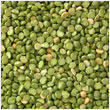Agricultural Products:
Pulses > Dry Peas
Dry Peas
Canada is normally the largest producer and exporter of dry peas in the world, accounting, on average, for about 25% of world production and 50% of world exports. The value of Canadian dry pea exports peaked at $492 million (M) in 2000-2001, but declined in the following two years due to reduced production caused by unfavorable weather. Exports started recovering in 2003-2004 and reached $408 million in 2004-2005. Canadian seeded area for dry peas increased by 565% since 1991-1992. The expansion of dry pea production in western Canada has provided producers with an alternative cash crop to use in their rotations and livestock feeders with a new feed ingredient.
 Canadian dry pea seeded area increased by 565% since 1991-1992, with a record 1.39 million hectares seeded in 2004-2005. There has also been an upward trend in average yields, which helped to increase production by 725% to a record 3.3 million tonnes (Mt) in 2004-2005. Canadian dry pea seeded area increased by 565% since 1991-1992, with a record 1.39 million hectares seeded in 2004-2005. There has also been an upward trend in average yields, which helped to increase production by 725% to a record 3.3 million tonnes (Mt) in 2004-2005.
Canada produces several types of peas, with the large and medium yellow types accounting for 68% of 2005-2006 production. Green peas accounted for 30% of the production and the remaining 2% consisted of maple, Austrian winter, green marrowfat and small yellow.
On average, about 65% of Canadian dry peas are exported. In 2004-2005, 31% of the exports went into the feed market, mainly in Europe, and 69% into the food market mainly in Asia and Latin America. The feed market consumes both yellow and green types. Although both yellow and green peas are sold into the food markets all over the world, the main market for green peas is Latin America and for yellow peas, Asia.
In Asia, the largest importer is India, followed by China, Bangladesh and Pakistan. In the western hemisphere, Cuba, Colombia, US, Venezuela and Peru are the largest importers. United Arab Emirates is the largest importer in the Middle East, with most of the imports re-exported to other countries in the region. Canadian exports are forecast to increase in 2005-2006 because of higher supply and strong demand in the feed markets in Europe and the food markets in Asia. (Agri-Canada)
|